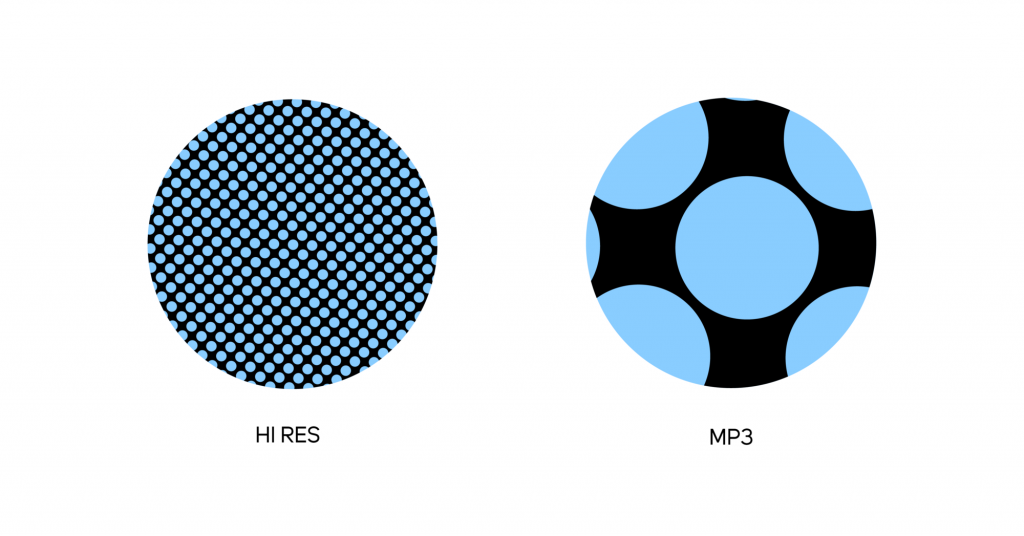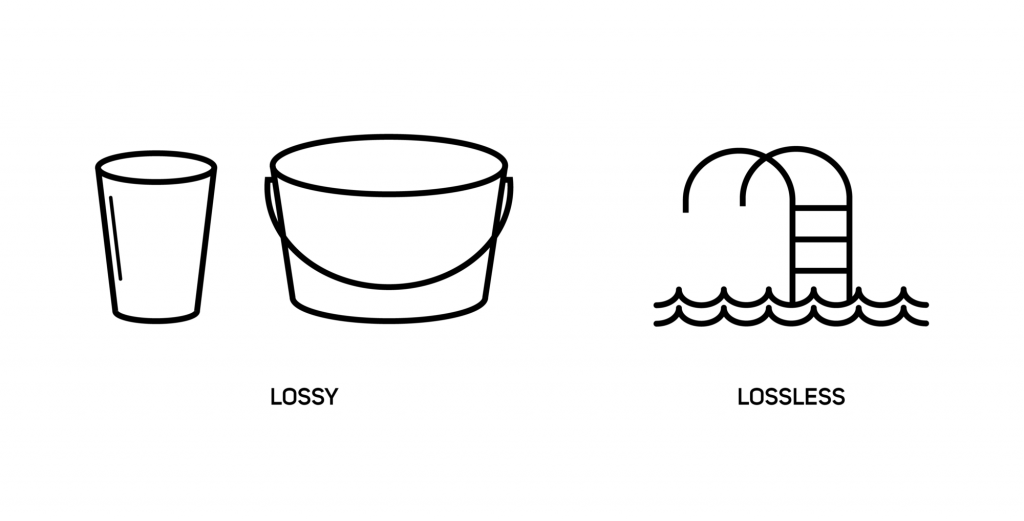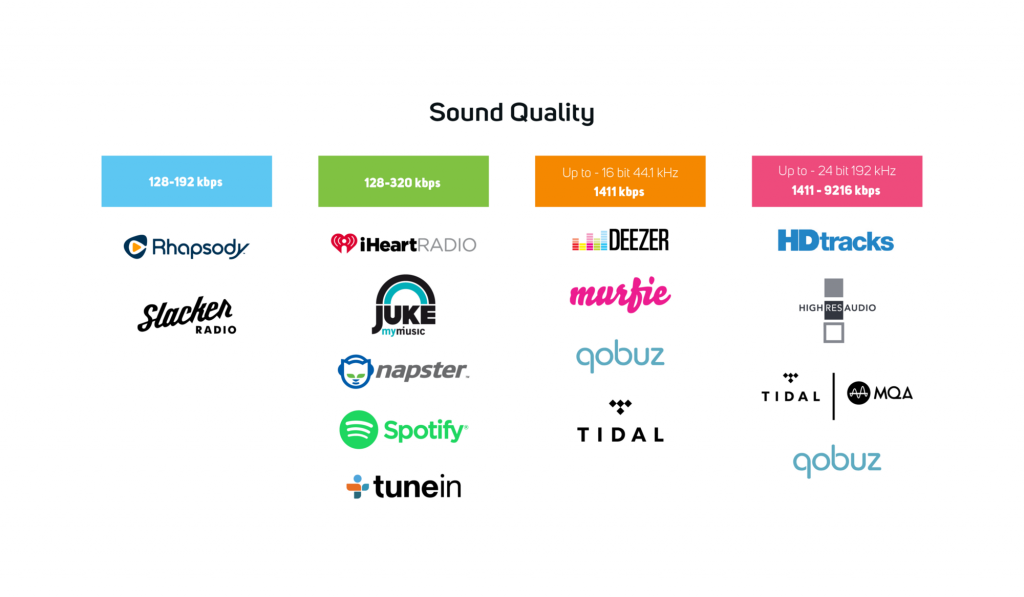Regardless of whether you choose to listen to your music on headphones, speakers, or even your car radio, it is also the quality of the music itself that matters. Believe it or not, the quality of the music that you listen to is more determined by bitrates and frequencies than whether you prefer blues over rock. While both genres have created great artists, it is the level of sound quality that truly makes their songs shine. Here at Bluesound, we are dedicated to creating a music experience that will produce the best sound quality possible. We have built our products to fully translate top quality audio formats. However, it is up to you as the listener to unlock the full potential of your favorite tracks by selecting the best audio format in which to hear them. So, how does one go about making this distinction between good and bad sound? Well, let’s talk a little bit of science.
The pitch of a sound is referred to as a frequency. This is measured in hertz, which is named after the scientist that quantified the phenomenon. Whether by choice or coercion you decided to play an instrument in life, you may recall something known as Middle A. Middle A, or simply the A note on a musical instrument, is 440 Hz. It is generally accepted that humans can hear tones in the range of 20 Hz to 20,000 Hz. “Music’s fundamental tones occur in the region of 32 Hz to about 5,000 Hz,” says Greg Stidsen, Director of Technology and Product Planning at Bluesound. “Musical harmonics can extend to about 16,000 Hz and some pipe organs go as low as 16 Hz — a frequency that is felt more than heard.”
“When choosing speakers and amplifiers, you want to be sure that the full ranges of musical frequencies can be reproduced without added noise (extra random frequencies added) or distortion (extra unwanted frequencies related to the music signal),” says Stidsen. Although selecting good quality products is key, it is only half the battle in finding the perfect sound.
While many would argue that sound quality is more or less subjective, there are ways to measure whether the music you are listening to is high quality or not. It may come as a surprise, but those CDs you’ve decided to either toss or cherish do have a superior sound quality. In fact, the bitrate of a CD is actually quite good. What the heck is bitrate you ask? Bitrate is the number of bits per second that can be transmitted along a digital network. “Digital audio converts the frequencies we hear into a binary code of 1’s and 0’s. Once coded, the digital file is very robust and can be sent at a very high speed over long distances without any degradation of the signal. When decoded back to analog we have a ‘perfect’ copy of the original audio signal. The conversion from music to code, and back again, requires very high precision electronics for accurate reproduction,” says Stidsen. Therefore, the more bits a song has, the greater the audio quality will be. To put this into perspective, a file that holds all the musical information has a bitrate of 9,216 Mbps, while a CD only has a bitrate of 1,411 kbps. That’s a fairly low number, but remarkably a lot better than the majority of your favorite music services, which is where we get into audio file formats.

There are many, many different kinds of audio file formats, and surprisingly some of the most familiar ones are actually not the best quality. “Once encoded, the digital file is often reduced in size — compressed — to allow for faster transmission or more economical storage. This digital compression (not to be confused with audio compression) can either be lossless (like FLAC, ALAC, MLP, and MQA) or lossy (like MP3, AAC, OGG, etc.),” says Stidsen. On one end of the spectrum we have lossless files, which “can be decoded perfectly without any loss of information, but the amount of data reduction is small.” On the other hand, lossy files can be reduced to a very small size. Stidsen says, “these are called ‘perceptual codecs’ because the noise created when the file size is compressed is ‘hidden’ underneath the louder parts of the music so it is masked and difficult to hear. The problem here is that you can never get back what is lost and sound quality suffers no matter how clever the codec.” So, although you can get this incredible sound quality, you will probably notice that the storage level on your various devices will decrease. This is because the higher the quality the bigger the file.
Let’s try and simplify. File formats are like containers. Musical information is like water. You have all of this information but you need a container to hold it.

With lossless compression you are going to get a pool’s worth of data, but a pool is large and difficult to take around with you. Lossy compression is like taking a cup or a bucket of that information to make it easier to maneuver and store. You can get different sizes of containers to store that information, which can make a big difference in how you hear it.
Once you take a smaller container of water you cannot add to it. The container will never hold more than its capable of. Similarly you would not be able to salvage musical information that has been lost through lossy compression.
Bitrate on the other hand, is the rate that water can flow to the listener. This information needs to flow through pipes. With music compression you can afford to have smaller pipes because there is less information. This is what made music streaming a viable option. Now that the price of pipes is going down, certain music services are investing into larger pipes so that you can get more water through. This means we have the ability to stream higher quality music.
“Common bitrates for lossy codecs like MP3 and AAC are 128kbps, 256kbps and 320kbps. On most music 320kbps sounds acceptable, but less than 128kbps is almost unlistenable,” says Stidsen. It is reasonable to sacrifice good sound quality for storage space, but even then it can be tricky to decide which songs stay and which songs go. Therein lie the benefits of music services. With music services such as Spotify and TIDAL, you have a vast amount of songs at your fingertips without having to worry about chewing into the memory space on your phone.

If you do happen to be one of those folks that ditched their CD collection, you most likely converted to using music services. While this personal choice is all well and good, would you believe it if we said those CDs actually have a higher sound quality than the likes of Spotify and iHeartRadio?
Interestingly enough, if you are seeking a music service that will project the same level of audio quality as your CDs, your best bet is to go with either TIDAL or Deezer. These services, along with a few others, are able to match the same bitrates as your favorite albums. However, even they can’t quite capture that elusive perfect sound, which is where processes such as MQA come into the picture.
As stated on their website, MQA “delivers master quality audio in a file that’s small enough to stream or download.” What’s also exciting about MQA, is that its backwards compatibility allows MQA processed tracks to play on any device. Therefore, you do not have to worry about loss of storage space in your pursuit of high quality sound. While MQA has the potential to be the definitive way to experience the full magic of an artist’s original recording, only time will tell if this revolutionary technology takes the music industry by storm.
All in all, the desire to find the best audio quality possible is a noble venture. As explored in this article, there are many ways to measure the level of quality of a song, whether it be by bitrates or the music services you listen to. Top quality products are also key, as they can translate those high quality audio formats and allow you to experience your favorite songs like never before. In the end though it will always come down to how you like to hear your music, and whether or not you are able to feel that deep connection to sound that makes music both impactful and personal.